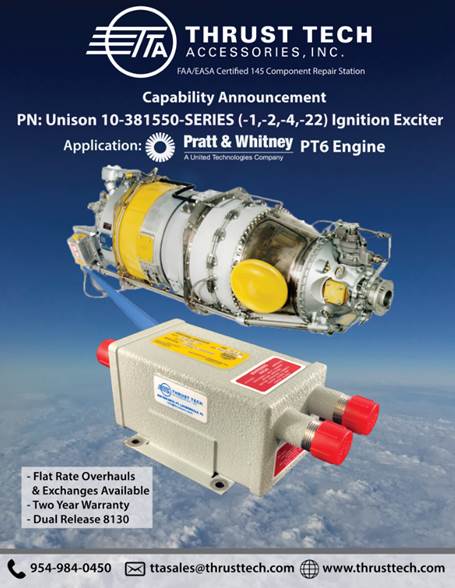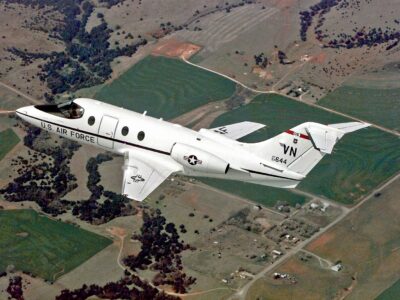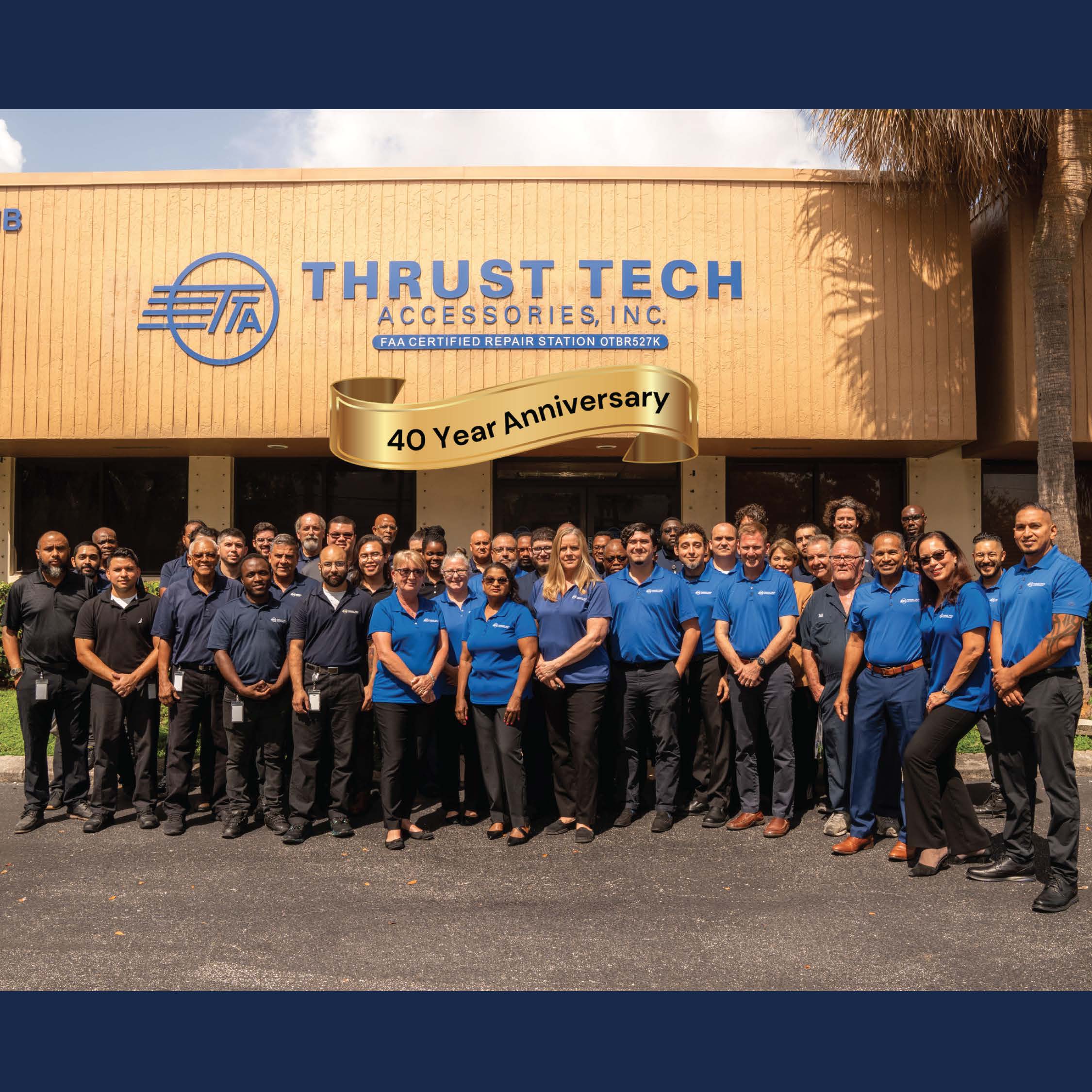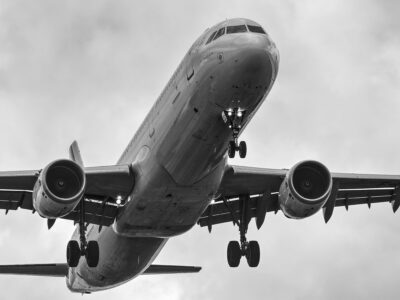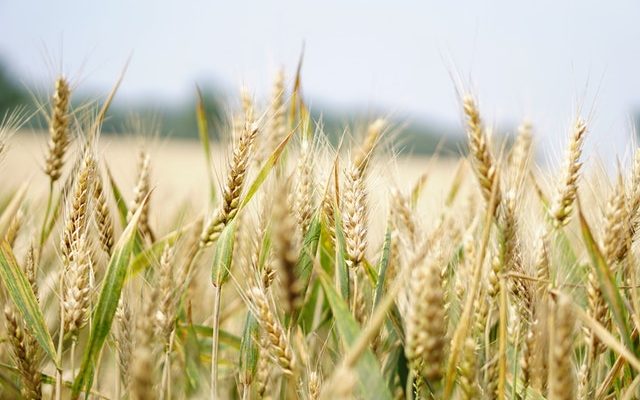
TTA Delivers with Effective, Efficient, Safe Solutions that Help Ensure the Safety and Airworthiness of Small Aircraft
In this ongoing series, Thrust Tech Accessories (TTA) shines a light on the many different aircraft types presently in service around the world. Join us as we explore the roles they play in the industries they serve and the challenges they may see in performing their important duties day-by-day, year-after-year, all across the globe. We also wish to underscore the key role that MROs like TTA play behind-the-scenes in providing overhaul, repair, and modification of engines and airframe accessory components that keep such aircraft flying properly, safely – and long into the future.
* * * * * * * * * * * * * * * *
Helping to keep Dusters & Top Dressers flying with expert MRO service and solutions
While most airplanes transport either people or cargo, other aircraft are highly specialized workhorses performing other vital roles. “Aircraft built or converted for agricultural use assure that there’s a strong support for the food that feeds the world,” says Stanley Kowlessar, president and general manager, Thrust Tech Accessories (TTA), a veteran MRO-services company that operates a state-of-the-art facility near Fort Lauderdale Executive Airport in South Florida.
“Agricultural aircraft are critical in helping farmers assure that their young plants not only survive but thrive from infancy to maturity, harvest and sale.”
At speeds of up to 140 mph, crop dusters swoop low across fields and from their aerial perch spray fungicides to prevent parasitic fungi or their spores or bugs from destroying agricultural crops. So-called “top dressers” are agricultural aircraft that also prepare the soil – fertilizing agricultural land to ensure the growth of strong, robust plants. Some agricultural aircraft also perform hydroseeding or hydraulic mulch seeding.
“But whatever their role, our customers’ agricultural aircraft are absolutely critical in the food chain,” says Kowlessar, “and at Thrust Tech we’re working to help keep these aircraft in tip-top condition with expert, timely MRO service and solutions.” With a solid reputation built over a 30-plus-year history, TTA services everything from fixed wing crop dusters or top dressers to select rotorcraft that also perform agricultural work.
Among the many “ag aircraft” that TTA can provide MRO services and solutions for are the Cessna AGwagon, Embraer EMB 202 Ipanema, Piper PA-36 Pawnee Brave, Pacific Aerospace PAC-750 XSTOL, and many others. Some are designed to handle humongous jobs such as Air Tractor’s single-engine ag plane, AT-802A with a payload of 9,249 pounds and an 800-gallon hopper. Such aircraft allow agriculturally-focused customers to work faster, stay longer over the fields, and complete more jobs in a single load.
Presently, the most popular unit that TTA supports for many of these very airframes that fly the PT6 engine – a remarkable engine with more than 51,000 engines delivered to power some 130 different applications – is the 10-381550-Series -1, -2, -4 & -22 ignition exciter.
The Early Days
In the U.S., agricultural aircraft use has a storied history. Today in Aviation explains that the world’s first crop dusting was conducted on August 3, 1921, under the direction of the Ohio Department of Agriculture by Lt. John A. Macready, a U.S. Army pilot. Yes, in fact, it was actual “dusting” as lead arsenate dust was spread over catalpa trees to kill moth larvae. Macready flew this agricultural mission in a modified Curtiss JN-6 “Super Jenny.”
In turn, in 1922, Curtiss biplanes were used to dust cotton fields near Tallulah, La, to control boll weevils. The actual first commercial agricultural flight was in 1923 by Huff-Daland Dusters, Inc. – interestingly, the predecessor of Delta Air Lines – first in Macon, GA, and then in Monroe, La. Huff-Daland operated a fleet of 18 self-designed, agricultural “Puffers” (as they were affectionately called) to control agricultural insect pests. At the time, the planes sported steel-tube fuselages, wooden wings and all-fabric coverings. They comprised the world’s largest private aircraft fleet.
Other firms soon joined this new agri-business stream. Today in Aviation reports that many firms used surplus World War II trainers or open-cockpit, Stearman biplanes, converted for agricultural use. The “dusting” of the initial phase of the industry was followed soon by use instead of insecticides and fungicides.
Today, aerial applications designed to control fungi, spores, and insect pests in large agricultural fields spray liquid crop protection in quite small doses. In addition, the United States Environmental Protection Agency provides guidelines for agricultural businesses and aircraft operators.
Certainly, the father of modern “aerial application aircraft” is widely considered to be the late Leland Snow, who was the “Thomas Edison of Agricultural Aviation.” In the early 1950s, he built his first crop duster, the S-1, at age 23. Over his career, he built thousands of different agricultural aircraft. Snow died in 2011 and his amazing agricultural aviation career was detailed well in this Flying Magazine story.
All aircraft come and go. That said, many of the aircraft still operated for crop dusting, top dressing or hydroseeding are no longer in production. In reality, some haven’t been manufactured in decades. Yet, many keep on flying – proving their mettle. Many also have been customized/modified. Routine maintenance, repairs and updates are all critical, as is incorporating the latest aircraft avionics and GPS technology for pinpoint precision in crop dusting.
Keeping Them in the Air
Most notably, “keeping ‘ag aircraft’ down-time to a minimum is absolutely critical,” says Kowlessar, “so our skilled experts and technicians will work one-on-one with our agricultural aircraft clients to assure their aircraft receive the repaired parts, new parts or upgrade solutions needed and in a timely manner. Our goal is to help customers get these specialized planes back in the air as quickly as possible.”
What U.S. states rely on agricultural aircraft the most? Certainly, these aircraft go where the farms are. According to Statista 2022, Texas is the top state for most farms – 247,000. Ranked second is Missouri with 95,000, followed by Iowa, Oklahoma, Ohio, Kentucky, Illinois, Tennessee, California, and Minnesota.
But much of the U.S. has sizable agricultural operations including TTA’s home state of Florida, the land of citrus, tomatoes, bell peppers and strawberries. The U.S. Department of Agriculture’s 2017 Census of Agriculture showed that Florida had 474,540 acres of citrus groves, second only to California and 57 percent of the national total.
Fortunately, wherever the need is, TTA is highly experienced at providing needed parts and shipping those and DER solutions for agricultural aircraft across the U.S. and across the globe. Why not give us a call to discuss your MRO needs? We’re ready to assist in this specialized form of aviation that’s so critical in protecting our national, state, and local agricultural economies.
About Thrust Tech Accessories
Thrust Tech Accessories supports a number of regional airlines across the U.S., along with overseas air carriers and rotorcraft operators in numerous countries around the globe. To find out more about TTA’s wide-ranging capabilities to support your fleet and to obtain competitive program bids, contact us via email at TTAsales@TrustTech.com or by calling 954-984-0450.
Read More
Review other articles in our series, including the mission of Rotorcraft in service to public safety and how they are keeping the world safe. Stay tuned for upcoming features on specialty type aircraft including Kodiak and Pilatus models.
PHOTO ABOVE: Tom Hauk

